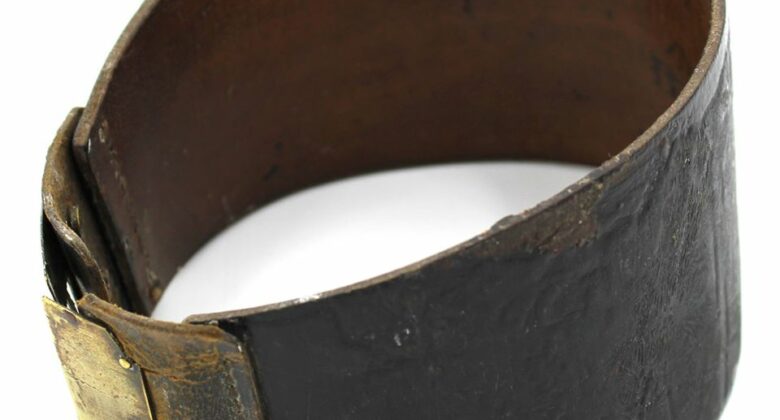The stock was a high neck collar worn around a soldier’s neck during the 19th century. Some were made of horsehair, whale bone, pig bristle or wood covered in cloth, the one in our collection from 1837 is leather.
A stock wrapped around the neck over the shirt and was secured by a metal clasp. Forming part of a soldier’s uniform, it was designed to improve their military bearing and appearance by forcing the chin high and posture straight. Due to its resistance to soiling, simplicity to put on and ease of replacement, it was considered suitable neckwear for soldiers.

However, the stock dug into the chin and neck with no material layer underneath making them extremely uncomfortable. It also reduced the agility and situational awareness of soldiers, making it almost impossible for a soldier to look down the sights of a musket. The military slang, ‘Leatherneck’, for US or British Marines is derivative of these collars.
Civilian Neckwear fashion
The stock is reflected in civilian fashion of the day in men’s neckwear. A wide, flat collar known as a falling band became popular in late 17th century. This evolved into bands, oblong pieces of cloth that survive today in ecclesiastic, legal and academic dress. Shortly, after this, the cravat became popular – a neckcloth popular among aristocrats that was made of white lace, muslin or linen. The Steinkirk cravat was a style left untied and drawn through a buttonhole on the coat. It was named after the 1692 Battle of Steenkerque and was said to have been improvised by soldiers on the battlefield who had no time to tie it. By the 18th century, the stock became the formal neckwear of choice amongst the wealthy and military officers who often opted for a black stock. Unlike the military stock, this would have been made of cloth which was tied or hooked in the back. This crossed into civilian fashion in 1840s-50s.
Whilst the stock was made redundant in military uniform by the end of the 19th century, the high neck collar was continued in the collars of soldier’s coats into the turn of the century and is still seen in the grenadier guards’ uniform today. Our collection of Cornwall volunteer uniforms across the 18th and 19th centuries showed the longer-lasting style of the 18th century jabot. It was held around the neck like a stock but made of cloth with lace and frills falling from the throat. This is mirrored in other uniforms and ceremonial dress, the jabot style is similar to what the speaker in the house of commons continues to wear today.

